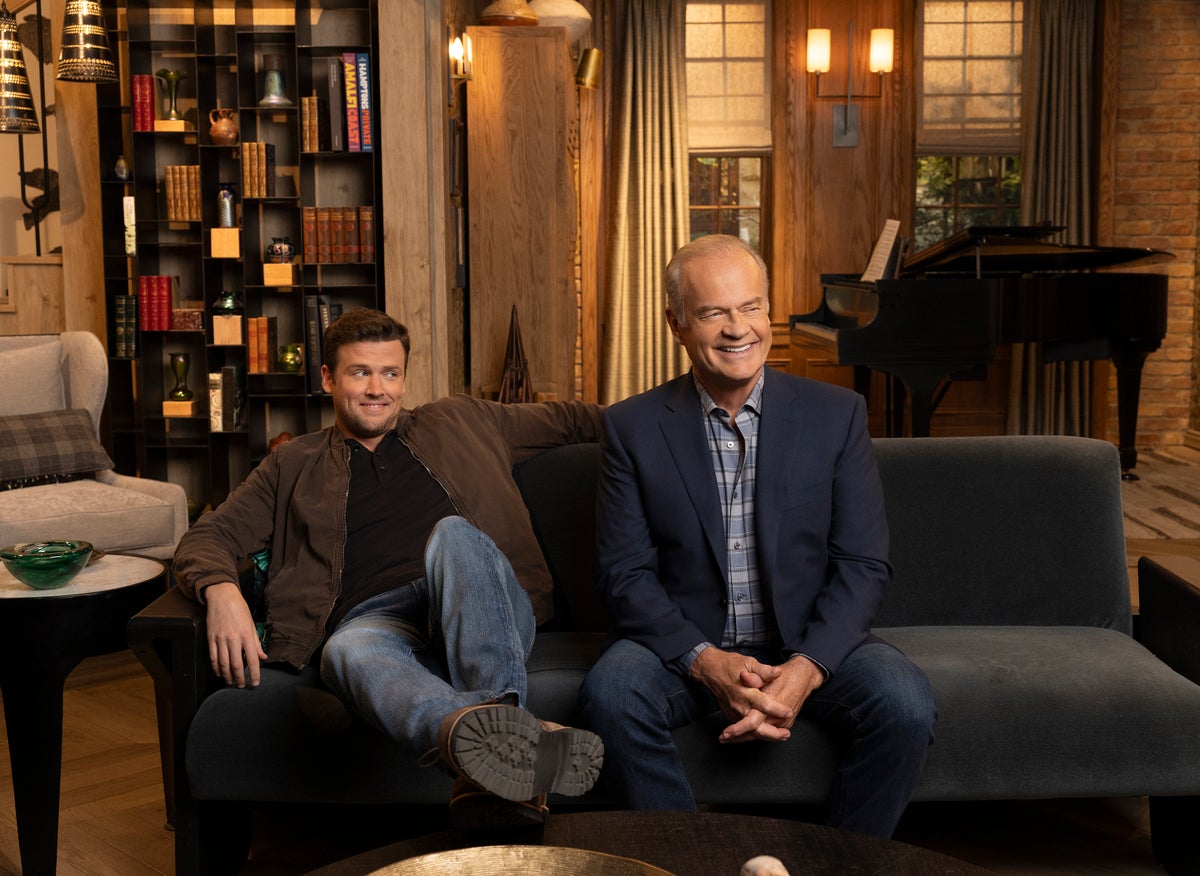
I’ll say this for the Frasier reboot: it’s not as bad as it could have been. Like most avid fans of Cheers and its first Kelsey Grammer-fronted spinoff, I’ve spent months wondering just what the new iteration would entail. Worst-case scenarios scratched at my mind like Freudian paranoias; mirthless visions of a necrotic Frasier Crane letching around Boston’s middle-aged singles scene plagued my nightmares. But we can breathe easy: the end result, which premieres on Thursday on Paramount+, is no catastrophe. It’s a functional, watchable sitcom, and Grammer is solid, if a little rusty. The series is, however, nearly entirely devoid of laughs, and – that most damning of qualities in the era of bottomless content – utterly forgettable.
Frasier (the reboot) follows Grammer’s snobby psychiatrist as he returns to his alma mater, Harvard, to take up a teaching position, while reconnecting with his firefighter son, Freddie (Jack Cutmore-Scott) and nephew David (Anders Keith). Much like the original, the series is filmed before a live studio audience, in a format referred to as a multi-camera sitcom. This is as opposed to a single-camera sitcom, such as The Office US or Modern Family. The delineation by camera is perhaps misleading; the difference usually pervades everything from dialogue, to performance, to staging. Over the past two decades, multi-camera sitcoms, once the only show in town, have been pushed to the brink of extinction. The new Frasier seems almost cluelessly dated at points, like a somehow-even-less-hip progeny of The Big Bang Theory. And yet, despite its fusty atavism, there’s something spiriting about seeing a series like this get made in 2023.
Multi-camera sitcoms might have a reputation for being corny, but it’s wrong to regard them as some sort of inchoate stepping stone that had to simply suffice before shows like The Office came along. As much as everyone loves to whinge about laugh tracks, the fact is that the old format had its advantages too – especially when it came to the sets. There is a reason why, say, Frasier’s apartment, or Jerry’s apartment in Seinfeld, or Central Perk cafe in Friends, are so fondly cherished by fans, while the sets of Parks and Recreation or Modern Family fail to inspire the same intensity of affection. It has to do with a sense of space, of the camera’s relationship with and proximity to a show’s physical location. At times, the original Frasier almost resembled a stage play, with Grammer expertly dialling up his performance for the cheap seats. The sets were optimised to accommodate the show’s affinity for farce: episodes like “The Ski Lodge” made masterful use of entrances and exits. It’s fair to assume “The Ski Lodge”, in which Frasier and co are embroiled in a tangle of sexual misunderstandings, would not translate properly to a single-camera format. Precisely understanding the set, how the doors interlink and mix-ups occur, is essential for the comedy to land.
The first episode of the new Frasier, titled “The Good Father”, throws itself half-heartedly into farce mode, with a mix-up involving Frasier, his son Freddie, and his son’s roommate Eve (Jess Salgueiro). It gestures at some of the series’ old favourites – swinging doors, misunderstood eavesdropping, ironic interplay between foreground and background action – with characters darting chaotically between the kitchen, living room and elsewhere. The new environments might lack the charm or arresting decor of Frasier’s Seattle bachelor pad, but it’s not just set dressing that’s the issue. James Burrows, the legendary sitcom director who worked on shows such as Taxi, Cheers, Frasier and Will & Grace – and who directed the first episode of the new Frasier at the age of 81 – wrote in his 2022 memoir about his “infatuation with different [elevational] levels on sitcom sets”. Citing the steps up to the terrace doors in Frasier’s apartment, he explains: “I believe this is all due to my training from the stage. Your eye is not watching one plane.” There is a real craft to blocking a traditional sitcom, a skill that flies under the notice of most viewers. That’s not to say that something like Parks and Rec is necessarily less adept when it comes to staging, but the considerations are different: modern sitcoms have more freedom to play around with framing shots, while multi-cam shows were forced to innovate within hard visual limitations.
It speaks to the growth of TV as a medium that it no longer derives so much of its inspiration from a single source (that being the theatre). The more cutting-edge modern comedies have borrowed from anything and everything – from European arthouse cinema (eg Master of None) to internet meme culture (The Eric Andre Show). But the symbiotic link between the screen and the stage was the backbone of TV comedy for decades, and it’s nice to see Frasier attempt to preserve this, however fumblingly. It’s too easy to assert that television has lost the ability to make sitcoms in the conventional style. Maybe we’ve just forgotten how to watch them.
‘Frasier’ premieres on Paramount+ on Thursday 12 October



!["[T]he First and Fifth Amendments Require ICE to Provide Information About the Whereabouts of a Detained Person"](https://images.inkl.com/s3/publisher/cover/212/reason-cover.png?w=600)



